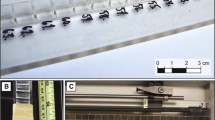Abstract
We describe a sledge microtome designed for the high-resolution subsampling of freeze cores. This inexpensive freeze-core microtome is capable of producing precise subsamples at mm to sub-mm resolution without sediment loss and cross-contamination. Such a subsampling resolution permits recognition of sub-decadal to annual events even in systems with low sedimentation rates. The freeze-core microtome is particularly useful for obtaining high-resolution subsamples at the environmentally important sediment-water interface due to freeze corers being capable of capturing this boundary with minimal disturbance as compared to other coring methods.



Similar content being viewed by others
References
Blass A, Bigler C, Grosjean M, Sturm M (2007) Decadal-scale autumn temperature reconstruction back to AD 1580 inferred from the varved sediments of Lake Silvaplana (southeastern Swiss Alps). Quat Res 68:184–195
Chang AS, Patterson RT (2005) Climate shift at 4400 years BP: evidence from high-resolution diatom stratigraphy, Effingham Inlet, British Columbia, Canada. Palaeogeogr Palaeoclimatol Palaeoecol 226:72–92
Cocquyt C, Israël Y (2004) A microtome for sectioning lake sediment cores at a very high resolution. J Paleolimnol 32:301–304
Gasiorowski M (2008) Deposition rate of lake sediments under different alternative stable states. Geochronometria 32:29–35
Glew JR, Smol JP, Last WM (2001) Sediment core collection and extrusion. In: Last WM, Smol JP (eds) Tracking environmental changes using lake sediments: volume 1: basin analysis, coring and chronological techniques. Kluwer Academic Publishers, Dordrecht, pp 73–106
Kulbe T, Niederreiter R Jr (2003) Freeze coring of soft surface sediments at a water depth of several hundred meters. J Paleolimnol 29:257–263
Lotter AF, Renberg I, Hansson H, Stöckli R, Sturm M (1997) A remote controlled freeze corer for sampling unconsolidated surface sediments. Aquat Sci 59:295–303
Mckay NP, Kaufman DS, Michelutti N (2008) Biogenic-silica as a high-resolution, quantitative temperature proxy at Hallet Lake, south-central Alaska. Geophys Res Lett 35: L05709. doi 10.1029GL032876
Patterson RT (1993) Late quaternary benthic foraminiferal biofacies and paleoceanography of Queen Charlotte sound and southern Hecate Strait, British Columbia. J Foraminiferal Res 23:1–18
Patterson RT, Prokoph A, Chang AS (2004) Late holocene sedimentary response to solar and cosmic ray activity influenced climate variability in the NE Pacific. Sediment Geol 172:67–84
Patterson RT, Prokoph A, Reinhardt A, Roe HM (2007) Climate cyclicity in late holocene anoxic marine sediments from the Seymour-Belize Inlet Complex, British Columbia. Mar Geol 242:123–140
Reading HG (1996) Sedimentary environments: processes, facies and stratigraphy. Blackwell Science (3rd ed), MA, USA
Renberg L (1990) A 12600 year perspective of the acidification of Lilia Öresjön, southwest Sweden. Philos Trans R Soc London, Ser. B 327:357–361
Smol JP (1995) Paleolimnological approaches to the evaluation and monitoring of ecosystem health: Providing a history for environmental damage and recovery. In: Rapport D, Gaudet C, Calow P (eds) Evaluating and monitoring the health of large-scale ecosystems. NATO ASI Ser, 128, pp 301–318
Acknowledgments
Development of the Sledge Freeze core microtome was supported by a NSERC Strategic Project Grant and Discovery grant to RTP. We particularly thank Steve Tremblay and his team at the Carleton University Science Technology Centre (STC) for their help with instrument design and manufacture of the prototype. The STC is also acknowledged for contributing the technical drawings presented in this contribution. Additional drawings are available through the primary author, while the complete blueprints are archived with the STC and available upon request.
Author information
Authors and Affiliations
Corresponding author
Rights and permissions
About this article
Cite this article
Macumber, A.L., Patterson, R.T., Neville, L.A. et al. A sledge microtome for high resolution subsampling of freeze cores. J Paleolimnol 45, 307–310 (2011). https://doi.org/10.1007/s10933-010-9487-4
Received:
Accepted:
Published:
Issue Date:
DOI: https://doi.org/10.1007/s10933-010-9487-4




